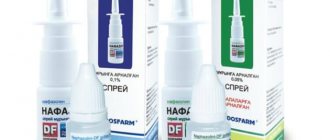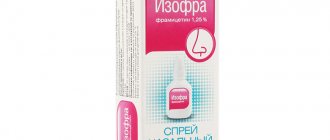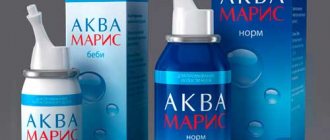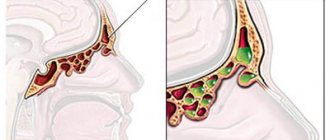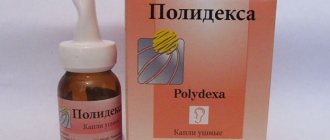Chemical composition of the solution
The main active ingredient is fluticasone. This glucocorticosteroid drug is a steroid hormone produced by the adrenal glands. The chemical compound has a high degree of selectivity; it reduces the rate of proliferation of structures that are directly involved in the formation of the immune response: eosinophils, mast cells, macrophages, neutrophils, lymphocytes. Fluticasone reduces the production and release of inflammatory mediators. Blocks the production of histamine, cytokines and other biologically active substances in all phases of the allergic process.
When exposed locally to mucous membranes, the drug is not absorbed into the systemic circulation. Therefore, it is safe for the functioning of internal organs and systems. A corticosteroid in therapeutic doses does not inhibit the activity of the endocrine system and does not disrupt the physiological level of hormones in the body. The drug does not affect the functionality of the central and peripheral nervous system, lungs and heart.
If the substance is accidentally ingested into the digestive tract, the level of systemic action is low, since the chemical compound undergoes rapid breakdown in the liver.
Excipients in the suspension:
- polysorbate 80 – binder for dosage forms;
- microscopic and dispersive cellulose – emulsifier, filler, moisture stabilizer;
- benzalkonium chloride – antimicrobial preservative;
- dextrose – crystalline glucose, filler;
- phenylethanol – alcohol, preservative;
- purified water.
Pharmacological features of the drug
Nazarel spray, by blocking histamine, relieves swelling of the nasal mucosa and restores normal breathing. Thanks to the resumption of aeration in the paranasal sinuses, the inflammatory process decreases, the hyperemia of the inner membrane becomes less pronounced.
Already after the first use of the solution, the active production of exudate by mucosal receptors stops. Nasal discharge stops and the nasal passages are cleared. The therapeutic effect occurs within 2-4 hours. The motor activity of the ciliated epithelium is restored, and the patient immediately feels relief when breathing. After irrigation of the mucous membrane, the following symptoms are eliminated:
- itching in the nose during ventilation;
- burning along the upper respiratory tract;
- rhinorrhea, nasal congestion;
- pain in the face;
- feeling of pressure in the eye area, paranasal sinuses.
Nazarel is a new generation drug; with a single use, the therapeutic effect lasts throughout the day. Treatment with hormones significantly improves the quality of life; people actively participate in social life and quickly restore their physical shape.
When administered intranasally, the drug is concentrated in the tissues. A small amount of hormones penetrates into the systemic bloodstream, which are not detected in blood tests. The solution is excreted by the intestines with bile after metabolic processes in the liver; the half-life of the substance does not exceed 3 hours.
Indications for use
Fluticasone shows itself to be an effective anti-inflammatory substance, which is explained by its effect on glucocorticoid receptors. When an allergy develops, it inhibits a number of cells and processes, due to which mediators and other highly active biological substances are released faster and the level of the product decreases.
The antiallergic effect of taking Nazarel can be noticed already 2-4 hours after it was used for the first time. This manifests itself in the fact that nasal congestion decreases, a person sneezes significantly less, and his nasal itching gradually goes away.
In addition, the manifestations of unpleasant symptoms of rhinitis become significantly less.
Namely:
- Painful sensations in the paranasal sinuses area disappear.
- The sensation familiar to everyone who has ever suffered from a runny nose goes away - as if something was pressing on the eye and nasal area.
- Negative eye symptoms are greatly alleviated by suppressing allergic rhinitis.
If you use Nazarel in therapeutic doses, the drug will not act: the hypothalamic-pituitary-adrenal system will not be affected in any way. It is also good that one dose is enough for a person to experience relief.
“Nazarel” is practically not absorbed by the mucous membrane and gastrointestinal tract due to a number of its features. The drug is excreted mainly through the intestines.
Indications for the spray
The drug is prescribed for the treatment of allergic rhinitis. The product can also be used for preventive purposes a month before the expected allergic reaction to flowering plants. Since the solution is safe for long-term use, it is prescribed to patients diagnosed with year-round allergic rhinitis.
Nazarel nasal spray is indicated for patients diagnosed with hay fever - an allergic disease associated with the effect of plant pollen on the mucous membrane, which is seasonal. The use of the drug relieves the symptoms of the disease, prevents damage to internal organs and systems and the development of bronchial asthma.
The main indications for the use of the suspension are obstruction of the upper respiratory tract (nose, sinuses) as a result of exposure to an allergic agent.
Nazarel is strictly contraindicated for a runny nose of infectious origin, since the hormonal solution blocks the functioning of the immune system and disables the protective functions of the mucous membrane. This promotes the proliferation of pathogenic flora and its spread throughout all organs of the respiratory system.
Release forms of the drug
The solution is available in the form of a homogeneous suspension. In appearance it is white, opaque, uniform.
The drug is available in darkened glass bottles and a dispenser for accurately measuring a single volume of the drug with each injection. The bottle is closed with a protective cap.
One dose contains 50 mcg of the active substance (fluticasone hormone).
The volume of the bottles varies. The cost of the drug in pharmacy chains depends on this.
Average prices for Nazarel spray:
- 60 doses – 190 rubles;
- 120 doses – 340 rubles;
- 150 doses – 410 rub.
Each bottle is placed in a cardboard package along with instructions for use.
Country of origin: Czech Republic.
Analogs are cheaper than Nazarela
According to the active substance, this medicine has the following analogues:
- Flixonase;
- Flixotide;
- Avamis;
All of these drugs can be used for rhinitis, as they are available in the form of aerosol sprays. But it is impossible to say that these analogues are cheaper than Nazarel. In fact, this is the most economical remedy in this series and it costs half as much as the more famous Flixonase.
Nazarel or Nasonex, which is better?
The question of which is better, Nazonex or Nazarel, is often asked by patients with allergic rhinitis - so it should be placed in a separate paragraph. The action of these drugs is similar. Their active components are different substances, but they belong to the same group.
Resolving such a dilemma is quite difficult. Based on the experience of patients, we can say that Nasonex is more likely to cause nosebleeds. And this forces doctors to offer patients other drugs - sometimes Nazarel. But, naturally, this reaction does not occur in everyone, and there are many people who, having tried various glucocorticosteroid sprays, settled on Nasonex.
Nazarel and Nasonex have slightly different indications. For example, for allergic rhinitis, Nasonex can be used for patients from two years of age, and Nazarel - only from four years.
The obvious advantage of Nazarel in this comparison is the price - it is the most economical drug.
Directions for use in children and adults
Nazarel drops are used only intranasally (in the nose).
Adults are prescribed 2 injections (100 mcg) into each nasal passage once a day. It is recommended to do the procedure in the morning. In rare cases of severe allergies, which are accompanied by intense inflammation and large swelling, the patient may be prescribed 2 doses 2 times a day (morning and evening). In this case, the maximum daily dosage should not exceed 400 mcg of fluticasone (4 injections into each nostril).
For elderly and debilitated patients, adjustment of the amount of medication is not necessary.
Children from 4 to 12 years old are prescribed 1 dose (50 mcg) in each nasal passage once a day. The maximum permissible dosage for small patients is 200 mcg of active substance per day (1 injection in the morning and evening). If possible, during treatment it is better to use the lowest dosage of the drug.
The key to successful therapy is regular use of the spray on a strict schedule.
Once opened, Nazarel is suitable for use only for 3 months. An open bottle does not require special storage conditions. The drug remains active at room temperature not exceeding 25°C. Avoid direct exposure to sunlight.
Rules for using hormonal agents in the nose:
- During initial use, it is necessary to calibrate (press the dosing device 5-6 times). This is necessary to regulate the precise supply of the active hormonal substance.
- Calibration is repeated if the solution has not been used for more than 7 days.
- Before irrigating the mucous membrane, you must thoroughly rinse your nose with saline solutions (Salin, Aqua Maris) and remove crusts.
- Insert the dispenser tip into the nasal passage and press sharply. In this case, the bottle must be in a strictly vertical position. Therefore, it is better to extend your head slightly forward during irrigation.
- While spraying, you can take a shallow breath, exhaling through your nose.
- Repeat the procedure with the second nasal passage.
After using the medicine, the dispenser must be blotted with a dry cloth and closed with a protective cap. The sprayer can be washed under water once a week. If the dispenser becomes clogged, it is strictly forbidden to clean it with sharp objects (a needle, a toothpick). This will damage the device and interfere with the accurate delivery of the medicinal solution.
Side effects
The frequency of side effects is classified in accordance with WHO recommendations: very often - at least 10%; often - at least 1%, but less than 10%; infrequently - not less than 0.1%, but less than 1%; rarely - not less than 0.01%, but less than 0.1%; very rarely (including isolated cases) - less than 0.01%.
From the immune system: rarely - bronchospasm, anaphylactic reaction; very rarely - skin hypersensitivity reaction, angioedema.
From the side of the central nervous system: often - headache, impaired taste, impaired sense of smell.
From the side of the organ of vision: very rarely - increased IOP, glaucoma, cataract.
From the respiratory system, chest and mediastinal organs: very often - nosebleeds; often - dryness and irritation of the nasopharynx mucosa; very rarely - perforation of the nasal septum.
From the skin and subcutaneous tissues: very rarely - ulceration of the subcutaneous mucous layer.
Other: very rarely - growth retardation in children, decreased function of the adrenal cortex, osteoporosis.
Interaction with other drugs is unlikely, since plasma concentrations of fluticasone are very low when administered intranasally. When used simultaneously with strong inhibitors of the CYP3A4 isoenzyme of the cytochrome P450 system (ritonavir), the systemic effect of fluticasone may be enhanced and side effects may develop (Cushing's syndrome, suppression of adrenal function).
| Category ICD-10 | Synonyms of diseases according to ICD-10 |
| J30.1 Allergic rhinitis caused by pollen | Hypersensitivity to pollen |
| Hay fever | |
| Polypous allergic rhinosinusitis | |
| Seasonal hay fever | |
| Seasonal rhinitis | |
| hay fever | |
| Hay runny nose | |
| J30.2 Other seasonal allergic rhinitis | Allergic rhinitis seasonal |
| Seasonal rhinitis of allergic nature | |
| J30.3 Other allergic rhinitis | Allergic rhinitis year-round |
| Allergic rhinoconjunctivitis | |
| J30.4 Allergic rhinitis, unspecified | Polypous allergic rhinosinusitis |
Aldecin
Polypous sinusitis
Polydexa
Polydexa is a French nasal spray based on dexamethasone and other active substances. It has a pronounced vasoconstrictor, anti-inflammatory, and antibacterial effect. Intended for the treatment of runny nose caused by sinusitis and rhinosinusitis.
Polydex spray is not recommended for use in the treatment of patients with angle-closure glaucoma, hypersensitivity to drug components, viral pathologies, and kidney diseases accompanied by albuminuria.
Polydexa can be prescribed to children starting from 2.5 years. From this age and up to 15 years, it is recommended to do 1 spray for each NH 3 times a day. Adults – 1 spray 3 to 5 times. The spray can cause allergic reactions of varying intensity, including skin reactions.
Rinoclenil
Rinoclenil is a hormonal spray based on beclomethasone. Indicated for patients for the treatment and prevention of allergic or vasomotor rhinitis. It is unacceptable to use the medication in case of individual intolerance to its components, tuberculosis, infectious lesions of the nose and age under 6 years.
Vasomotor rhinitis
Dosage features: 2 injections into each NH 1 time/day. Children can take 1 injection of the drug twice a day. The duration of therapy is determined individually.
Treatment with Rinoclenil may provoke hypersensitivity or allergic reactions. Itching, burning, lacrimation, formation of ulcers on the nasal mucosa, nosebleeds are the most common adverse reactions. But they do not always require discontinuation of the drug.
Tafen Nasal is a Swiss GCS for intranasal use. Contains AB budesonide. Prescribed for various types of rhinitis and polypous sinusitis. Contraindicated in patients with pulmonary tuberculosis, hypersensitivity to budesonide, and infectious diseases of the nasopharynx.
Tafen can cause PD in the form of hoarseness, sore throat, sneezing or coughing. Nosebleeds occur less frequently, or a secondary fungal infection occurs.
Tafen should be administered to adults and patients over 6 years of age, 2 doses/nostril twice a day. Correction of the treatment regimen can only be done by an ENT specialist (if necessary).
Tafen differs from Nasonex in price and composition. It also has some differences in application, indications and contraindications.
Flixonase
Spanish spray with fluticasone, which helps reduce swelling and eliminate inflammation and allergies. The drug is indicated for patients with different types of rhinitis. Under its influence, not only a runny nose goes away, but also nasal congestion. The vasoconstrictor effect lasts approximately a day.
The occurrence of side effects (itching and burning in the nose, nosebleeds, the appearance of wounds or ulcers on the mucous membrane, etc.) is often observed in patients who have contraindications to the use of Flixonase in the form of hypersensitivity to its components.
Fluticasone
Fluticasone is an intranasal spray intended for the treatment of seasonal or year-round runny nose caused by allergies. Prescribed for adults and pediatric patients from 4 years of age.
Recommended dosages:
- 4-12 year old children: 1 dose/NC/day. If necessary, the dosage can be doubled.
- 12 year olds and adults: 2 doses/NC/day. Sometimes the frequency of use of the drug may be not 1, but 2 times/24 hours.
Year-round allergic rhinitis
Treatment with Fluticasone may cause an unpleasant taste or odor in the mouth, headaches, and nosebleeds.
Flutinex
Flutinex contains fluticasone and is used for the treatment or prevention of seasonal/perennial allergic rhinitis, including hay fever. The drug is recommended to be used as follows:
- 2 doses/NH 1 time per day. It is advisable to carry out the manipulation in the morning. This dosage is designed for adults and adolescents over 12 years of age.
- Children from 4 to 12 years: 1 dose/NC, 1 time per day. The maximum dose is 2 injections into each NH per day.
Flutinex rarely causes side effects. The most common ailments are headaches, nosebleeds, dryness or irritation of the nasal mucosa.
Contraindications for use
The drug is not prescribed to small patients under 4 years of age. Homones are contraindicated in case of increased sensitivity of the body to chemical components.
The spray is prescribed with caution for the following conditions:
- bacterial infection of the mucous membrane of the lower respiratory tract;
- herpetic rashes in the area of the nasolabial triangle;
- mechanical facial injuries;
- operations in maxillofacial surgery;
- simultaneous use with other hormonal drugs for local and general use.
Theoretically, Nazarel is not prescribed during pregnancy. But in gynecological and obstetric practice, a woman can be prescribed the drug in the 2nd and 3rd trimester, when the risks of abnormal development of the child are reduced. In this case, a woman should be observed by a doctor more often and monitor changes in her health. If your allergy symptoms worsen or intensify, you should immediately stop using the spray.
There is no evidence that the hormone passes into breast milk. But as a precaution, during treatment, a woman is advised not to breastfeed her child, but to transfer him to artificial feeding.
Contraindications
The drug should not be used in the following cases:
- Pregnancy and lactation;
- Use in patients under 4 years of age;
- Hypersensitivity or individual intolerance to Nazarel or its components.
Use with caution:
- Ulcerations of the nasal mucosa;
- Previous surgical interventions on the nasal cavity;
- Simultaneous use of GCS;
- Concomitant bacterial or herpetic infection of the respiratory system.
Possible side effects
During local hormonal therapy, the following side effects may occur:
- itching and redness of the skin;
- irritation of the nasal mucosa;
- increased congestion and swelling of the upper respiratory tract;
- rarely - rupture of the nasal septum.
In children, there have been cases of bronchospasm, severe swelling of the face and throat, which led to suffocation, and anaphylactic shock.
With long-term therapy with high doses of hormonal solution, the following pathologies develop:
- dysfunction of the adrenal cortex;
- systemic skeletal disease associated with decreased bone density;
- increased intraocular pressure;
- cataract – clouding of the lens of the eye;
- delayed physical growth in children.
There were no signs of overdose in patients during treatment with Nazarel.
Special instructions for treatment with hormonal spray
The drug does not react chemically with other pharmacological agents. When taken simultaneously with ART drugs (antiretroviral therapy used for HIV infection), the systemic effect of Nazarel may increase, which will lead to suppression of adrenal function or the development of Cushing's syndrome (excessive production of adrenal hormones).
During long-term treatment, it is necessary to constantly monitor the patient's hormonal levels. To do this, blood tests are prescribed to monitor the functionality of the endocrine system. Children's growth and physical activity are monitored. If necessary, the dose is adjusted.
If the patient is constantly in a zone of increased allergenicity, then the dosage is increased according to indications.
If there are contraindications to the use of Nazarel or restrictions in the patient’s budget, analogue drugs are selected for treatment, cheaper in cost:
- Avamis;
- Flixonase;
- Sinoflurin;
- Cutivate;
- Zyrtec;
- Nasonex.
Nazarel is a safe drug for the treatment of allergic rhinitis. If used correctly and the dosage is followed, the development of side effects is unlikely. Since the medicine is not absorbed into the systemic bloodstream, it does not interfere with the functioning of internal organs. The spray is prescribed to children and the elderly to relieve symptoms of seasonal or year-round allergies affecting the nasal mucosa and paranasal sinuses.
The drug is compatible with drugs of different pharmacological groups. With caution, local Nazarel is prescribed for infectious and inflammatory processes in the body. Since hormones reduce immunity and promote the proliferation and colonization of bacteria.

